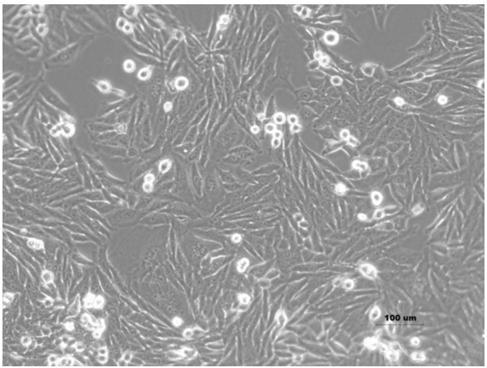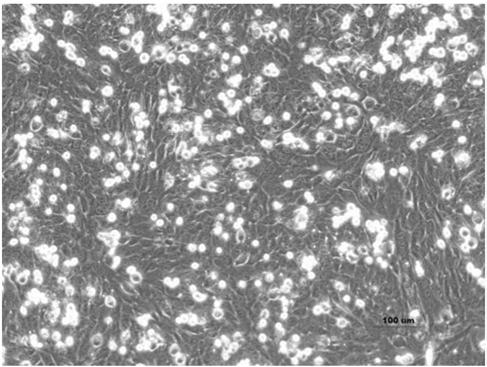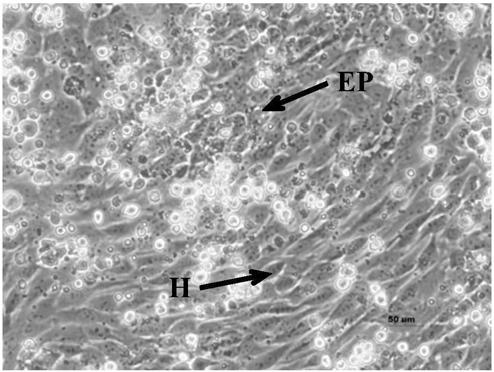In vitro 3D liver model, enterohepatic co-culture model, building methods of the models and applications of the models
A method and model building technology, applied in 3D culture, biochemical equipment and methods, tissue culture, etc., can solve problems such as lack of, lack of in vitro models, etc.
- Summary
- Abstract
- Description
- Claims
- Application Information
AI Technical Summary
Problems solved by technology
Method used
Image
Examples
Embodiment 1
[0081] The establishment of an in vitro 3D liver model comprises the following steps:
[0082] 1. Cell culture.
[0083] HepaRG cells (source: ATCC, purchased by Guangzhou Geneo Biological Co., Ltd.) and human hepatic stellate cells (Human Hepatic Stellate Cell, HHSC, source: ScienCell, purchased by Beijing Yuhengfeng Technology Co., Ltd.) The RPMI 1640 complete medium (containing 10% FBS) was used for cell culture, and the cells grew well and were used for future use.
[0084] Incubate the above cells at 37°C with 5% CO 2Culture in an incubator with a relative humidity of 90%, replace the medium every other day, and subculture after 2 to 3 days of adherent growth and cover 80% to 90% of the bottom of the bottle.
[0085] Second, cell induction.
[0086] exist T150 conventional culture bottle was inoculated with 2×10 6 HepaRG cells were incubated with 1640 complete medium containing 10% FBS at 37 °C in 5% CO 2 and cultured in an incubator with a relative humidity of 90...
Embodiment 2
[0120] The establishment of an in vitro intestinal-liver co-culture model, comprising the following steps:
[0121] 1. Establishment of intestinal absorption model.
[0122] 1. Model establishment.
[0123] 1.1. Prepare cell suspension: when MDCKII / Caco-2 cells grow to 80%-90% of the bottom of the bottle, digest with trypsin and stop digestion with culture medium, centrifuge at 1000rpm for 5min, and then use RPMI1640 containing 10% FBS Complete medium was prepared at a density of 2 × 10 6 cells / ml of cell suspension.
[0124] 1.2. Add fresh 1640 blank culture solution containing 10% FBS to each well on the side of the Transwell receiver pool (bottom well) (keep the pages of the receiver pool and the supply pool flush).
[0125] 1.3. Add the prepared cell suspension (equivalent to 1×10 6 cells / 1.12cm 2 ).
[0126] 1.4. Place at 37°C, 5% CO 2 Cultured in an incubator, the medium was replaced every other day.
[0127] 1.5. Measure the transmembrane resistance after 15 day...
experiment example 1
[0149] Albumin and urea secretion level experiments.
[0150] 1. Albumin secretion level.
[0151] At different time points of cell culture, the albumin expression levels in Example 1 and Comparative Example 1 were measured by albumin kit and high-content fluorescent labeling. The result is as Figure 10 shown.
[0152] The results show that after the hanging drop 3D liver model and scaffold 3D liver model prepared in Example 1 were cultured for 3 days, the secretion of albumin reached a higher level, and both were significantly higher than the 2D culture level (more than 2 times the same number of cells) . And this level has been maintained until 30 days after culture.
[0153] Second, the level of urea secretion.
[0154] At different time points of cell culture, the expression level of cells to albumin was measured with urea kit, and the results were as follows: Figure 11 shown.
[0155] The results showed that after 5 days of culture in the hanging drop 3D liver mo...
PUM
 Login to View More
Login to View More Abstract
Description
Claims
Application Information
 Login to View More
Login to View More - R&D
- Intellectual Property
- Life Sciences
- Materials
- Tech Scout
- Unparalleled Data Quality
- Higher Quality Content
- 60% Fewer Hallucinations
Browse by: Latest US Patents, China's latest patents, Technical Efficacy Thesaurus, Application Domain, Technology Topic, Popular Technical Reports.
© 2025 PatSnap. All rights reserved.Legal|Privacy policy|Modern Slavery Act Transparency Statement|Sitemap|About US| Contact US: help@patsnap.com



